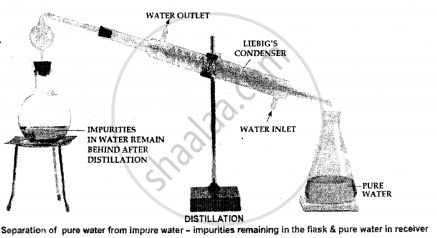Advertisements
Advertisements
प्रश्न
Pure water from impure water
- Give the principle involved in the separation of the mixture
- Give the technique of separation of the mixture.
उत्तर
By Distillation
Principle- Based on the distillation of the liquid component in a soluble solid-liquid mixture.
Distillation – It is the process of converting a liquid into vapour by heating in a distillation flask & subsequent condensation of the vapour back into the liquid.
The method is used to separate a liquid from a soluble solid or pure liquid [water] from impure liquid [impure water].
The technique of Separation The soluble solid can be separated from its liquid component or pure water from impure water by placing the mixture i.e. impure water in the distillation flask.
On heating the distillation flask
The solid or solid impurities in the water remain behind in the distillation flask
The liquid or water vaporizes, condenses in the Liebig’s condenser, and is collected in the receiver.

APPEARS IN
संबंधित प्रश्न
Give a brief description of the principle of the following technique taking an example.
Distillation
Give one word answer
The liquid which evaporates and then condenses during the process of distillation
Methyl alcohol and water
- Give the principle involved in the separation of the mixture
- Give the technique of separation of the mixture.
Choose the correct option.
Which of the following techniques is used for the separation of glycerol from soap in the soap industry?
Why is a condenser used in distillation process?
Which of the tubes in Fig. 2.1 (a) and (b) will be more effective as a condenser in the distillation apparatus?

Match the type of mixture of compounds in Column I with the technique of separation/purification given in Column II.
| Column I | Column II |
| (i) Two solids which have different solubilities in a solvent and which do not undergo reaction when dissolved in it. | (a) Steam distillation |
| (ii) Liquid that decomposes at its boiling point | (b) Fractional distillation |
| (iii) Steam volatile liquid | (c) Simple distillation |
| (iv) Two liquids which have boiling points close to each other | (d) Distillation under reduced pressure |
| (v) Two liquids with large difference in boiling points. | (e) Crystallisation |
Draw a diagram of bubble plate type fractionating column. When do we require such type of a column for separating two liquids. Explain the principle involved in the separation of components of a mixture of liquids by using fractionating column. What industrial applications does this process have?
What is distillation?
A mixture of benzene and chloroform is separated by ______.
